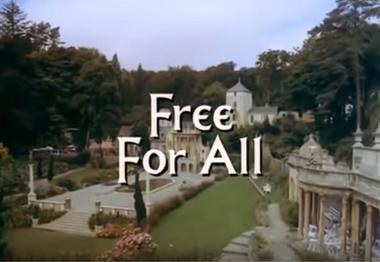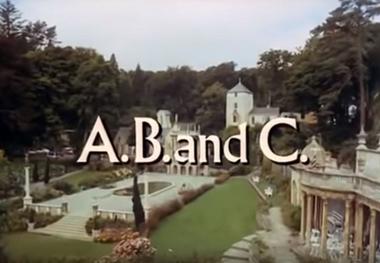
Rewind & Rewatch: The Prisoner – The Chimes of Big Ben

I will start the second episode rewatch with my prologue from the first episode (and will most likely continue this practice throughout the series)–as a caveat and introduction. I’ll put this intro into an indented section to make it easier for people who’ve read it to skip it and get to the current episode.
I am starting a Rewind & Rewatch series on The Prisoner (the 1967 British series, created by Patrick McGoohan and George Markstein and starring McGoohan). I’ll be following the DVD episode order throughout this rewatch. In this series, I am merely looking for things of interest to me, ideas I find striking. This series is decidedly not a comprehensive review of The Prisoner, and these are certainly not my final thoughts on the TV series. It’s more like a set of notes. With any good piece of art, one can continually come back to it and find fecundity: missed elements, new relevancies, new avenues for thought. And, of course, there is already quite a bit of media surrounding the series, e.g., Time for Cakes and Ale has a separate podcast (“The Tally Ho”) reviewing the episodes, there is a fantastic website dedicated to the show (The Unmutal Website, which has articles and links to more writing about the show)–and, of course, there are numerous pop culture references to it. Despite all of this great content, I still feel compelled (for the sheer love of the show) to demonstrate my deficiencies! So, here we go…
Leo McKern plays Number Two in this episode. I must add, being the huge Beatles fan that I am, Leo McKern will always be Clang to me (“Shocking”).

Of course, McKern was an excellent stage and screen actor with numerous roles, and here he puts in a fine performance (for example, his deliciously dripping anger and exasperation with Number Six in the line delivery, “He can make even the act of putting on his dressing-gown appear as a gesture of defiance!”). His updating of Number Six’s file to reflect his humor is a great sequence as well.

The idea of placating the villagers is still present–it’s right at the off in the announcements blasted over the radio to Number Six’s room. The arts and crafts exhibition is an attempt at paternalistic persuasion.
The chess game with the colonel is a set-up for Number Six to show his intellectual superiority (he asks a few sharp questions of the colonel and reveals his acumen; he bests the colonel–after he leaves–in seven moves). And this is obviously not the last time chess will be used as an essential symbol in the series (or explicit reference).
Number Six’s ability for keen observation plays out later in the episode, as we meet Nadia and are led to believe that she, too, is a prisoner trying to escape–who is then later revealed to be an operative playing an elaborate game designed to get Number Six to reveal his secret. It almost works, of course, but Number Six’s acumen again comes to his aid.

Of course, it’s no secret (or great insight as this point) to note that the series plays with the themes of individualism and collectivism. For example, in Chris Gregory’s Be Seeing You: Decoding The Prisoner (1997), he notes that McGoohan saw these themes differently than some audience members. The notion that Number Six was merely a stand-in for individualism, and that the show as a whole championed this view, was a mistaken one: “The idea that The Prisoner is purely a manifesto for individualism has been challenged by McGoohan himself: ‘…the series was conceived to make it APPEAR that our hero was striving to be “completely free” , “utterly himself”. Too much of that and society would be overcome by rampant extremists and there would be anarchy. The intention was satirical. Be as free as possible within our situation, but the war is with Number 1′” (103).

A conversation partner in this discussion is Martha Nussbaum, who challenges the myth of the so-called “autonomous individual.” Nussbaum has a method known as the capabilities approach. Her text, Sex and Social Justice (Oxford University Press, 1999), lists components of what a full human experience consists: 1. Life (of course, being able to live); 2. Bodily health (including reproductive health, nourishment, shelter, etc.); 3. Bodily integrity (freedom to move, security from assault, reproductive choices, etc.); 4. Senses, imagination, and thought (being able to use the senses, to imagine, to think, and to reason); 5. Emotions (having attachments to things and persons, being able to love, being able to grieve, being able to experience longing and gratitude, having justified anger, and not having one’s emotional developing blighted by fear or anxiety); 6. Practical reason (being able to form a conception of the good and to engage in critical reflection about the planning of one’s own life); 7. Affliation (being able to live for and in relation to others, to recognize and show concern for other human beings, to engage in various forms of social interaction; being able to imagine the situation of another and to have compassion for that situation; having the capability for both justice and friendship); 8. Other species (being able to live with concern for and in relation to animals, plants, and the world of nature); 9. Play (being able to laugh, to play, to enjoy recreational activities); 10. Control over one’s environment (political and material).
Her conception provides a push against the idea of the ‘rugged individual,’ who has no connections (except those of choice)–and a more Hobbesian approach to the individual. James Rachels sums up this approach with something like the following:
1. Of equality of need (i.e., the idea that each of us needs the same basic things to survive—food, shelter, clothing–and although we may differ in some of our needs, we are all essentially very much alike.
2. The fact of scarcity (i.e., that the world is a hard, inhospitable place; things we need to survive are not in ready supply; they are hard to produce; there is not enough to go around).
3. The essential equality of human power (i.e., if there are not enough goods to go around who get them (because each of us will want as much as we can get? But will we be able to overcome that competition from others?
4. The idea of limited altruism (i.e., if we cannot prevail by our own strength, what hope do we have? Can we rely on the charity of others? No. People may not be completely selfish, but they do care very much about themselves, and one cannot assume that others will step aside when our needs are not being met.
5. So, to escape this state of nature, people must agree to establish rules to govern their relations with one another, and they must agree to the establishment of a seat of power to enforce rules.
But Nussbaum points to the limits of individualistic approaches by trying to come to a fuller idea of what it means to be human in a society. There is a balance she is trying to create between a sense of community and a sense of individual integrity. Similarly, The Prisoner‘s message can be seen as a recognition that individualism is not, on its own, the answer, but neither can we subsume the individual in favor of the collective. There has to be a balance between the two approaches—some combination of asserting individualism and recognizing the need for community.
Thanks for reading–and I’ll be back soon to continue my rewatch of The Prisoner. “Be seeing you”…





